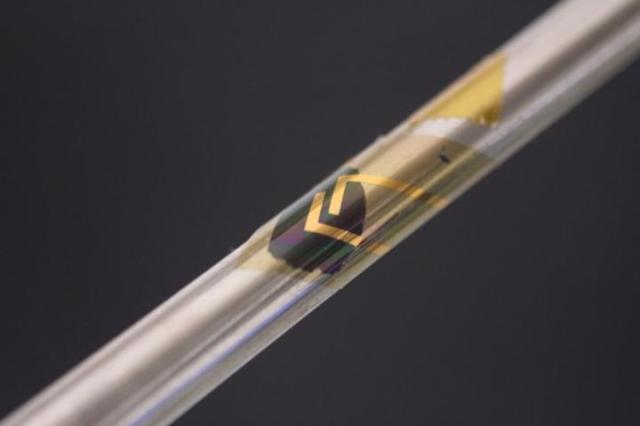Nov 11 2015
A University of Tokyo research group has developed a flexible, lightweight sensor that responds rapidly to tiny thermal changes in the range of human body temperature. This sensor is expected to find healthcare and welfare applications in devices for monitoring body temperature, for example of newborn infants or of patients in intensive care settings.
 The printable sensor is thin and flexible enough to wrap around a pencil, or adapt to the form of the human body or another substrate. Device performance is largely unaffected by bending. Credit: 2015 Someya Laboratory
The printable sensor is thin and flexible enough to wrap around a pencil, or adapt to the form of the human body or another substrate. Device performance is largely unaffected by bending. Credit: 2015 Someya Laboratory
Flexible and wearable devices are increasingly being developed for healthcare and other applications where temperature and other sensors are integrated to provide feedback on patient health and wellbeing. Body temperature is a fundamental measurement and many low-cost flexible temperature sensors have been demonstrated, but devices developed to date require external circuitry to amplify the signal to allow accurate temperature measurement.
In their latest research, Professor Takao Someya and Dr. Tomoyuki Yokota's research group at the Graduate School of Engineering have developed a new printable, flexible, lightweight temperature sensor that shows a very high change in electrical resistance of up to 100,000 times over a range of just five degrees centigrade, allowing accurate temperature measurement without additional complicated display circuitry.
The key to the new sensor is the ability to precisely control the target temperature of the sensors. The sensor is composed of graphite and a semicrystalline acrylate polymer formed of two monomers, molecules that bond together to form a polymer chain. The target temperature range at which the sensor is most precise can be selected simply by altering the proportions of the two monomers. The research group achieved target temperatures between 25 and 50 degrees centigrade, a range which includes average human body temperature, and simultaneously realizing response times of less than 100 milliseconds and a temperature sensitivity of 0.02 degrees centigrade. The device was also stable even under physiological conditions, providing repeated readings up to 1,800 times.
The research group tested their new sensor by printing a flexible thermal monitoring device which was placed directly on the lung of a rat to measure lung temperature. The device successfully measured cyclic changes in lung temperature of just 0.1 degrees centigrade as the animal breathed, demonstrating its utility as a sensor for monitoring body vital signs in physiological (internal) settings.
"By printing an array of these sensors it is possible to measure surface temperature over a large area," says Professor Someya. He continues, "This sensor array can be attached to biological tissue such as the skin for precise monitoring in medical applications. Because the huge response of the sensor to temperature change allows us to simplify the circuitry, we could print our sensors onto adhesive plasters that could then monitor body temperature. For example, a plaster applied directly to a wound or after surgery could provide warning of infection by detecting local changes in temperature due to inflammation."
Other possible applications include wearable electronic apparel, where the sensor could be applied beneath fabric to measure temperature during sporting and other activities.